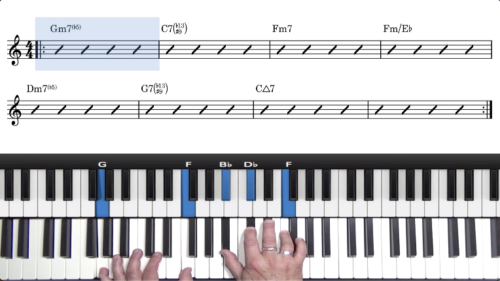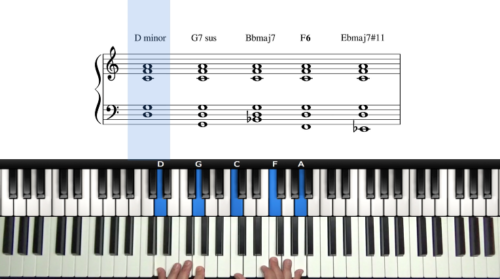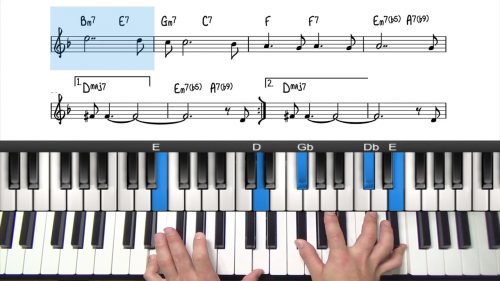Arpeggio Shapes & Patterns
In this lesson we will introduce arpeggio runs and arpeggio patterns that we can use in our improvisations. We will combine arpeggios with targeting the chord tones that we have explored in the previous lessons.
Triad Runs
We start with the most basic application of arpeggios which is arpeggiating the triads which are within the 7th chords. This works well when the melody rests for example in bars 1, 3, and the turnaround section.
7th Chord Arpeggios
We can then create arpeggios from 7th chord shapes to create richer sounding arpeggios. Of course we have the basic 7th chord but we can also incorporate the chord extensions such as 3-5-7-9, and 5-7-9-11.
Major 7th Arpeggios
For the first chord Ebmaj7, we can take the notes of a G-7 arpeggio which is the 3-5-7-9 of Eb Major. This creates more a more colourful and interesting sound than the basic root position 7th chord arpeggio. We can also create major arpeggio patterns such as 3-5-7-9 / 7-R-3-5 as demonstrated in the lesson.
Minor 7th Arpeggios
For minor chords we can incorporate the 11th into our arpeggios. This works well because unlike major chords, there is a whole step between the minor 3rd and the 11. We can play patterns such as 3-5-7-9 / 5-7-9-11 or starting on the 5th to play 5-7-9-11 / 9-3-5-7.
Chord Alterations & Altered Arpeggios
In the next next 2 lessons we will delve into the world of chord alterations which will add interesting tensions and flavours to our improvisations.
We will start with a common altered arpeggio pattern and then we will learn to target the individual alterations over each dominant chord in the A section of “Misty”.
Lesson Downloads
-
Arpeggio Shapes & Patterns File Type: pdf
Practice Tips
-
Start by identifying the triads that reside within the 7th chords to create arpeggio shapes and patterns.
-
Next explore the 7th chord and extended arpeggios over the major and minor chords.
-
A whole solo of arpeggios would sound a little repetitive but when used tastefully they are a useful improvisational tool.
-
Remember that these components to do not exist in isolation and they must be combined and intertwined with chord tones and approach patterns.







